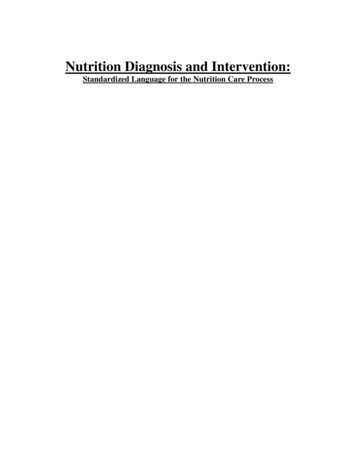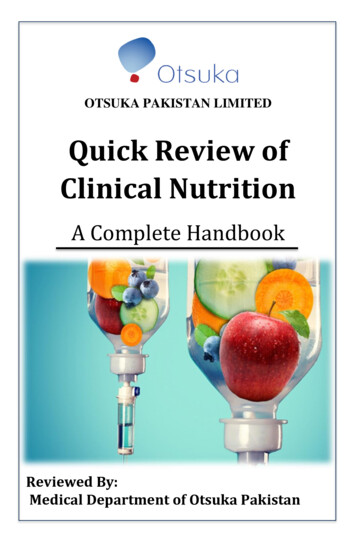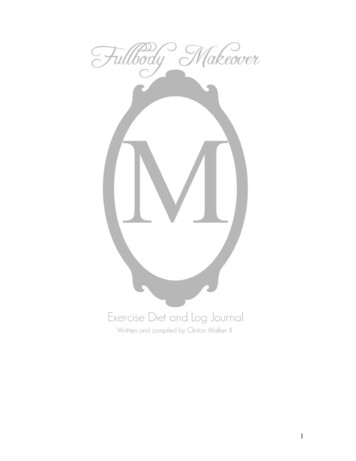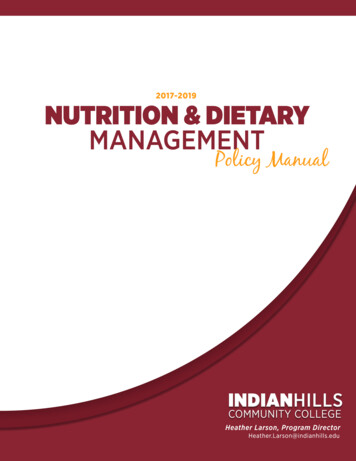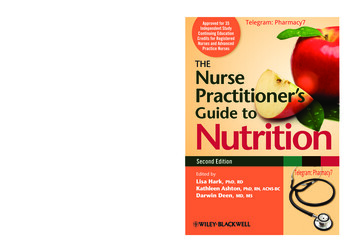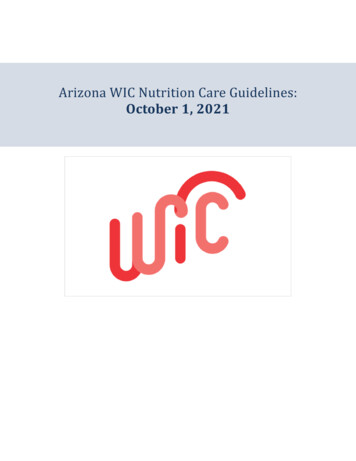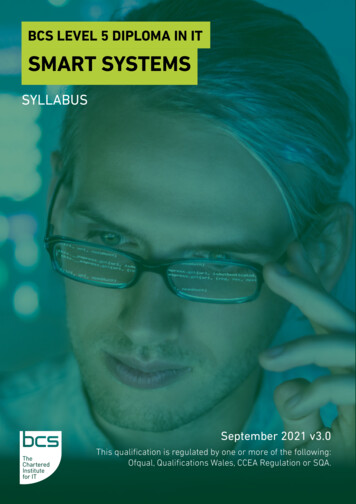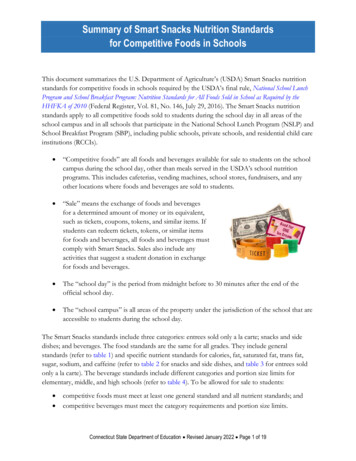
Transcription
Summary of Smart Snacks Nutrition Standardsfor Competitive Foods in SchoolsThis document summarizes the U.S. Department of Agriculture’s (USDA) Smart Snacks nutritionstandards for competitive foods in schools required by the USDA’s final rule, National School LunchProgram and School Breakfast Program: Nutrition Standards for All Foods Sold in School as Required by theHHFKA of 2010 (Federal Register, Vol. 81, No. 146, July 29, 2016). The Smart Snacks nutritionstandards apply to all competitive foods sold to students during the school day in all areas of theschool campus and in all schools that participate in the National School Lunch Program (NSLP) andSchool Breakfast Program (SBP), including public schools, private schools, and residential child careinstitutions (RCCIs). “Competitive foods” are all foods and beverages available for sale to students on the schoolcampus during the school day, other than meals served in the USDA’s school nutritionprograms. This includes cafeterias, vending machines, school stores, fundraisers, and anyother locations where foods and beverages are sold to students. “Sale” means the exchange of foods and beveragesfor a determined amount of money or its equivalent,such as tickets, coupons, tokens, and similar items. Ifstudents can redeem tickets, tokens, or similar itemsfor foods and beverages, all foods and beverages mustcomply with Smart Snacks. Sales also include anyactivities that suggest a student donation in exchangefor foods and beverages. The “school day” is the period from midnight before to 30 minutes after the end of theofficial school day. The “school campus” is all areas of the property under the jurisdiction of the school that areaccessible to students during the school day.The Smart Snacks standards include three categories: entrees sold only a la carte; snacks and sidedishes; and beverages. The food standards are the same for all grades. They include generalstandards (refer to table 1) and specific nutrient standards for calories, fat, saturated fat, trans fat,sugar, sodium, and caffeine (refer to table 2 for snacks and side dishes, and table 3 for entrees soldonly a la carte). The beverage standards include different categories and portion size limits forelementary, middle, and high schools (refer to table 4). To be allowed for sale to students: competitive foods must meet at least one general standard and all nutrient standards; andcompetitive beverages must meet the category requirements and portion size limits.Connecticut State Department of Education Revised January 2022 Page 1 of 19
Summary of Smart Snacks Nutrition Standardsfor Competitive Foods in SchoolsFoods and beverages are evaluated for compliance with Smart Snacks based on the amount of thefood/beverage item as served, including any added accompaniments such as butter, cream cheese,syrup, ketchup, mustard, and salad dressing. Some food categories have exemptions for specificnutrient-rich foods that are naturally higher in fat (such as reduced-fat cheese, seafood, nuts, seeds,and whole eggs) or sugars (such as dried fruit). If applicable, these are indicated in the “Exemptions”column for each standard. There are no exemptions for the beverage categories.The CSDE’s guides for competitive foods (Guide to Competitive Foods in Non-HFCPublic Schools; and Guide to Competitive Foods in Private Schools and Residential Child CareInstitutions) provide detailed information on how the state and federal requirementsapply to sales of foods and beverages. The CSDE’s List of Acceptable Foods andBeverages webpage identifies foods and beverages that comply with the federal andstate requirements.Requirements for FundraisersThe Smart Snacks nutrition standards apply to all fundraisers selling foods and beverages to studentson school campus during the school day. “Fundraisers” are any activities during which money or itsequivalent (such as tickets, coupons, tokens, and similar items) is exchanged for the purchase of aproduct in support of the school or school-related activities. This includes any activities that suggesta student donation in exchange for foods and beverages, since funds may be raised as a result. Foods and beverages that comply with the Smart Snacks standards can be sold at fundraiserson school campus during school hours, provided they comply with the state competitivefoods regulations and any additional state restrictions. Foods and beverages that do not comply with the Smart Snacks standards can only be soldat fundraisers on the school campus after the end of the school day, provided they complywith any additional state restrictions. The Smart Snacks standards do not apply to foods and beverages sold during non-schoolhours, weekends, or off-campus fundraising events. However, some additional staterestrictions apply.For more information on the state restrictions for competitive foods, refer to “Additional StateRequirements for Competitive Foods” in this document. For detailed guidance on complying withthe Smart Snacks fundraiser requirements, refer to the CSDE’s competitive foods guide for theConnecticut State Department of Education Revised January 2022 Page 2 of 19
Summary of Smart Snacks Nutrition Standardsfor Competitive Foods in Schoolsappropriate type of school or institution: Guide to Competitive Foods in Non-HFC Public Schools; andGuide to Competitive Foods in Private Schools and Residential Child Care Institutions.Additional State Requirements for Competitive FoodsSome stricter provisions of Connecticut statutes and regulations supersede Smart Snacks and requireadditional restrictions for foods and beverages sold to students in schools. Public schools that choose the healthy food option of Connecticut’s Healthy FoodCertification (HFC) under Section 10-215f of the Connecticut General Statutes (C.G.S.)must comply with the Connecticut Nutrition Standards (CNS), which exceeds SmartSnacks. HFC public schools must also comply with the Smart Snacks beverage standardsand the stricter provisions of state statutes and regulations, including the state beveragestatute (C.G.S. Section 10-221q), the state statute requiring healthy food choices (C.G.S.Section 10-221p), and the state competitive foods regulations (Sections 10-215b-1 and10-215b-23 of the Regulations of Connecticut State Agencies). For more information, referto the CSDE’s resources, Allowable Beverages in Connecticut Public Schools, Overview of ConnecticutCompetitive Foods Regulations, and Requirements for Competitive Foods in HFC Public Schools. Non-HFC public schools must comply with the Smart Snacks standards for foods andbeverages and the stricter provisions of state statutes and regulations, including C.G.S.Section 10-221q, C.G.S. Section 10-221p, and the state competitive foods regulations. Formore information, refer to the CSDE’s resources, Allowable Beverages in Connecticut PublicSchools, Overview of Connecticut Competitive Foods Regulations, and Requirements for Competitive Foodsin Non-HFC Public Schools. Private schools and RCCIs must comply with the Smart Snacks standards for foods andbeverages and the stricter provisions of the state competitive foods regulations. For moreinformation, refer to the CSDE’s resources, Overview of Connecticut Competitive Foods Regulationsand Requirements for Competitive Foods in Private Schools and RCCIs.For more information, visit the CSDE’s HFC, CNS, and Beverage Requirements webpages. TheCSDE’s guides for competitive foods provide detailed guidance on complying with the state andfederal requirements for competitive foods for each type of school or institution guides (refer to“Resources” in this document).Connecticut State Department of Education Revised January 2022 Page 3 of 19
Summary of Smart Snacks Nutrition Standardsfor Competitive Foods in SchoolsGeneral Standards for FoodsThe general standards in table 1 apply to all competitive foods in the categories of entrees sold onlya la carte and side dishes. Entree items offered as part of the NSLP or SBP are exempt from allcompetitive food standards if they are sold as a competitive food on the day of service or the dayafter service in the lunch or breakfast program, and are offered in the same or smaller portion sizesas the NSLP and SBP, and with the same accompaniments. For information on the nutrientstandards for entrees, refer to table 3.Table 1. General standards for competitive foodsStandardTo be allowable, a competitive food itemmust meet all of the competitive foodnutrient standards (refer to table 2 and table3) AND:1. be a grain product that contains 50percent or more whole grains byweight or has whole grains as thefirst ingredient*; OR2. have as the first ingredient* one ofthe non-grain main food groups:fruits, vegetables, dairy, or proteinfoods (meat, beans, poultry, seafood,eggs, nuts, seeds, etc.); ORExemptions Fresh fruits and vegetables with no addedingredients except water are exempt from allnutrient standards. Canned and frozen fruits with no addedingredients except water, or that are packed in100 percent juice, extra light syrup, or lightsyrup, are exempt from all nutrient standards. Low sodium/no salt added cannedvegetables with no added fats are exemptfrom all nutrient standards.3. be a combination food that containsat least ¼ cup fruit and/or vegetable.* If water is the first ingredient, thesecond ingredient must be one of theabove.Public schools that choose to implement the healthy food option of HFC underC.G.S. Section 10-215f must comply with the CNS instead of the USDA SmartSnacks standards. For more information, visit the CSDE’s CNS and HFC webpages.Connecticut State Department of Education Revised January 2022 Page 4 of 19
Summary of Smart Snacks Nutrition Standardsfor Competitive Foods in SchoolsNutrient Standards for FoodsThe nutrient standards in table 2 apply to all competitive foods in the category of snacks and sidedishes. This category includes all foods that do not meet the definition of entree items. Examplesinclude, but are not limited to: fruits and vegetables (fresh, frozen, canned, and dried);pasta, rice, and cooked cereal grains, e.g., quinoa, bulgur, and bulgur;snack foods such as chips, crackers, popcorn, rice cakes, hard pretzels, pita chips, snack mix,and trail mix;breakfast cereals, e.g., cold ready-to-eat (RTE) cereals and cooked hot cereals such asoatmeal;nuts and seeds;peanut butter and other nut butters, e.g., almond butter and sunflower seed butter;dried meat snacks, e.g., beef jerky and meat sticks;bakery items, e.g., pastries, toaster pastries, muffins, waffles, pancakes, French toast, softpretzels, rolls, and buns;desserts, e.g., cookies, brownies, cake, pie, and pudding;frozen desserts, e.g., frozen fruit bars, ice cream, and ice cream novelties;cereal bars and granola bars;cheese, e.g., low fat cheese sticks and low-fat cheese cubes;yogurt and soy yogurt; andschool-made fruit/vegetable smoothies. Note: Smoothies that also contain a meat/meatalternate such as yogurt or peanut butter meet the entree definition (refer to table 3).Exemption for sugar-free chewing gumSugar-free chewing gum is exempt from all Smart Snacks standards, provided the sales comply withthe state competitive foods regulations. Section 10-215b-23 of the Regulations of Connecticut StateAgencies requires that the income from any foods and beverages sold to students anywhere onschool premises from 30 minutes before up through 30 minutes after any of the USDA’s schoolnutrition programs must accrue to the nonprofit food service account. For more information, referto the CSDE’s resource, Overview of Connecticut Competitive Foods Regulations, the CSDE’s guides forcompetitive foods (refer to “Resources” in this document), and CSDE Operational MemorandumNo. 1-18: Accrual of Income from Sales of Competitive Foods in Schools.Public schools that choose to implement the healthy food option of HFC underC.G.S. Section 10-215f must comply with the CNS instead of the USDA SmartSnacks standards. For more information, visit the CSDE’s CNS and HFC webpages.Connecticut State Department of Education Revised January 2022 Page 5 of 19
Summary of Smart Snacks Nutrition Standardsfor Competitive Foods in SchoolsTable 2. Nutrient standards for snacks and side dishesSnacks and side dishes are evaluated for compliance with the Smart Snacks nutrient standardsbased on the amount of the food item as served, including any added accompaniments such asbutter, margarine, oil, cream cheese, jam, jelly, syrup, sugar, salt, ketchup, mustard, relish, saladdressing, barbeque sauce, gravy, dipping sauce, sour cream, and whipped cream.StandardExemptionsCalories: No morethan 200 calories peritem as served,including any addedaccompaniments suchas butter, cream cheese,and salad dressing.Entree items served as a NSLP or SBP entree are exempt on theday of or day after service in the program meal.Total fat: No morethan 35 percent ofcalories from total fat asserved, including anyadded accompaniments. Reduced fat cheese (including part-skim mozzarella) is exemptfrom the total fat standard. Nuts and seeds and nut/seed butters are exempt from the totalfat standard. Products consisting of only dried fruit with nuts and/or seedswith no added nutritive sweeteners or fats are exempt from the totalfat standard. Seafood with no added fat is exempt from the total fat standard. Whole eggs without added fat are exempt from the total fatstandard.Combination products other than paired exempt foods are notexempt and must meet all the nutrient standards.Connecticut State Department of Education Revised January 2022 Page 6 of 19
Summary of Smart Snacks Nutrition Standardsfor Competitive Foods in SchoolsTable 2. Nutrient standards for standards for snacks and side dishes, continuedStandardSaturated fat: Lessthan 10 percent ofcalories from saturatedfat as served, includingany addedaccompaniments.Exemptions Reduced fat cheese (including part-skim mozzarella) is exemptfrom the saturated fat standard. Nuts and seeds and nut/seed butters are exempt from thesaturated fat standard. Products consisting of only dried fruit with nuts and/or seedswith no added nutritive sweeteners or fats are exempt from thesaturated fat standard. Whole eggs without added fat are exempt from the saturated fatstandard.Combination products other than paired exempt foods are notexempt and must meet all the nutrient standards.Trans fat: Zero gramsof trans fat as served(no more than 0.5 gramper portion), includingany addedaccompaniments.NoneSugar: No more than35 percent of weightfrom total sugar, asserved. Dried whole fruits or vegetables; dried whole fruit or vegetablepieces; and dehydrated fruits or vegetables with no added nutritivesweeteners are exempt from the sugar standard. Dried whole fruits or pieces, with nutritive sweeteners that arerequired for processing and/or palatability purposes (i.e., driedcranberries, tart cherries, or blueberries) are exempt from the sugarstandard. Products consisting of only exempt dried fruit with nuts and/orseeds with no added nutritive sweeteners or fats are exempt fromthe sugar standard.Connecticut State Department of Education Revised January 2022 Page 7 of 19
Summary of Smart Snacks Nutrition Standardsfor Competitive Foods in SchoolsTable 2. Nutrient standards for standards for snacks and side dishes, continuedStandardExemptionsSodium: No more than 200 milligrams of sodium per item as served,including any added accompaniments.NoneAccompaniments: Use of accompaniments is limited when competitivefood is sold to students in school. The accompaniment must be included inthe nutrient profile as part of the food item served and meet all proposedstandards. Examples of accompaniments include butter, margarine, oil,cream cheese, jam, jelly, syrup, sugar, salt, ketchup, mustard, relish, saladdressing, barbeque sauce, gravy, dipping sauce, sour cream, and whippedcream.NoneCaffeineNone* Elementary and Middle Schools: Foods and beverages must becaffeine-free with the exception of trace amounts of naturallyoccurring caffeine substances. High School: Foods and beverages may containcaffeine. *Public schools: The stricter caffeine standards of C.G.S. Section10-221q supersede the Smart Snacks beverage standards. The statebeverage statute prohibits sales of caffeinated beverages (such as tea andcoffee) to students in public schools at all times, unless the beveragesmeet specific exemption criteria. For more information, refer to“Additional state beverage requirements for public schools” in thisdocument and visit the CSDE’s Beverage Requirements webpage.Connecticut State Department of Education Revised January 2022 Page 8 of 19
Summary of Smart Snacks Nutrition Standardsfor Competitive Foods in SchoolsTable 3. Nutrient standards for entrees sold only a la carteAny entree item offered as part of the NSLP or SBP is exempt from all competitive foodstandards if it is sold as a competitive food on the day of service or the day after service in thelunch or breakfast program. Exempt entrees that are sold as competitive foods must be offeredin the same or smaller portion sizes as the NSLP and SBP, and with the sameaccompaniments. Entrees are evaluated for compliance with the Smart Snacks nutrientstandards based on the amount of the food item as served, including any addedaccompaniments such as butter, margarine, oil, cream cheese, jam, jelly, syrup, sugar, salt,ketchup, mustard, relish, salad dressing, barbeque sauce, gravy, dipping sauce, sour cream, andwhipped cream.An “entree item” is a main dish food from one of following three categories: a combination food of meat/meat alternate and whole grain-rich food;a combination food of vegetable/fruit and meat/meat alternate; ora meat/meat alternate alone, with the exception of yogurt, low-fat or reduced fat cheese,nuts, seeds, nut and seed butters and meat snacks.School-made fruit/vegetable smoothies that also contain a meat/meat alternate such as yogurtor peanut butter meet the entree definition.Grain-only items at breakfast: At breakfast only, the entree definition also includes wholegrain-rich grain-only items, such as bagels, muffins, and waffles. Schools can determine whichgrain-only items are defined as entree items for breakfasts offered as part of the SBP.StandardExemptionsCalories: No more than 350 calories per item as servedincluding any added accompaniments.Entree items served as a NSLP orSBP entree are exempt on the dayof or day after service in the programmeal.Total fat: No more than 35 percent of calories from totalfat as served including any added accompaniments.Seafood with no added fat isexempt from the total fat standard.Saturated fat: Less than 10 percent of calories fromsaturated fat as served including any addedaccompaniments.NoneConnecticut State Department of Education Revised January 2022 Page 9 of 19
Summary of Smart Snacks Nutrition Standardsfor Competitive Foods in SchoolsTable 3. Nutrient standards for entrees sold only a la carte, continuedStandardExemptionsTrans fat: Zero grams of trans fat as served (no morethan 0.5 gram per portion) including any addedaccompaniments.NoneSugar: No more than 35 percent of weight from totalsugar as served.NoneSodium: No more than 480 milligrams of sodium peritem as served including any added accompaniments.NoneCaffeineElementary and middle school: Foods and beveragesmust be caffeine-free with the exception of trace amountsof naturally occurring caffeine substances. *None*Public schools: The stricter caffeine standards ofC.G.S. Section 10-221q supersede the SmartSnacks beverage standards. The state beveragestatute prohibits sales of caffeinated beverages (suchas tea and coffee) to students in public schools at alltimes, unless the beverages meet criteria. For moreinformation, refer to “Additional state beveragerequirements for public schools” in this documentand visit the CSDE’s Beverage Requirementswebpage.Nutrient Standards for BeveragesThe Smart Snacks nutrition standards define five categories of beverages that may be sold toelementary and middle students, and seven categories of beverages that may be sold to high schoolstudents. There are no exemptions to these beverage categories.For high schools only, no calorie or low-calorie beverages in the category of “flavored and/orcarbonated beverages” are evaluated for compliance with the Smarts Snacks nutrition standardsbased on the amount of the beverage item as served, including any added accompaniments, e.g.,coffee with milk, cream and sugar, tea with milk, cream and honey, and hot chocolate with milk andmarshmallows.Connecticut State Department of Education Revised January 2022 Page 10 of 19
Summary of Smart Snacks Nutrition Standardsfor Competitive Foods in SchoolsPrivate schools and RCCIs must comply with the Smart Snacks beverage standards. Public schools(HFC and non-HFC) must comply with the Smart Snacks beverage standards and the stricterprovisions of the additional state beverage requirements indicated below.Additional state beverage requirements for public schoolsIn addition to complying with Smart Snacks, all Connecticut public school districts must complywith the state beverage requirements of C.G.S. Section 10-221q. Some stricter provisions of the statebeverage statute supersede the Smart Snacks beverage standards. Beverages that do not complywith C.G.S. Section 10-221q cannot be sold to students in public schools even if they meetthe Smart Snacks standards. This statute does not apply to private schools or RCCIs.The Smart Snacks beverage standards apply only to beverages sold to students separately fromschool meals during the school day, in schools and institutions that participate in the USDA’sschool nutrition programs. The state beverage statute applies to all public schools, regardless ofwhether they participate in the USDA’s school nutrition programs, and to all beverages sold tostudents at all times, either as part of school meals or separately from school meals.Beverages that do not meet the requirements of state statute can only be sold to students in publicschools if the local board of education or school governing authority votes to allow exemptions, andthe beverages are sold at the location of an event that occurs after the school day or on the weekend,provided they are not sold from a vending machine or school store. An “event” is an occurrencethat involves more than just a regularly scheduled practice, meeting, or extracurricular activity, e.g.,soccer games, school plays, and school debates are events but soccer practices, play rehearsals, anddebate team meetings are not. For more information on beverage exemptions, refer to the CSDE’sresource, Exemptions for Foods and Beverages in Public Schools.For more information on the state beverage requirements for public schools, refer to the CSDE’sresources, Allowable Beverages in Connecticut Schools and Beverage Requirements for Connecticut Public Schools(presentation). The CSDE’s guides for competitive foods (refer to “Resources” in this document)provide detailed guidance on complying with the state and federal requirements for beverages inschools.Beverages that comply with federal and state requirements are included on theCSDE’s List of Acceptable Foods and Beverages webpage.Connecticut State Department of Education Revised January 2022 Page 11 of 19
Summary of Smart Snacks Nutrition Standardsfor Competitive Foods in SchoolsTable 4. Standards and portion size limits for beveragesBeverage categoryElementaryMiddleHighLow-fat (1%) milk, unflavored 18 fluid ounces(fl oz)12 fl oz12 fl ozNonfat milk, flavored or unflavored 1including nutritionally equivalent milkalternatives permitted by the school mealrequirements 28 fl oz12 fl oz12 fl oz100% fruit/vegetable juice 38 fl oz12 fl oz12 fl oz100% fruit/vegetable juice diluted withwater and no added sweeteners (with orwithout carbonation) 48 fl oz12 fl oz12 fl ozPlain water (with or without carbonation) 5UnlimitedUnlimitedUnlimitedCalorie-free, flavored water (with orwithout carbonation)Not permittedNot permitted20 fl oz *Flavored and/or carbonated beverages 6 Less than 5 calories per8 fluid ounces * or No more than 10 calories per20 fluid ounces *Not permittedNot permitted12 fl oz *Flavored and/or carbonated beverages 6 No more than 40 calories per8 fluid ounces * or No more than 60 calories per12 fluid ounces *Not permittedNot permitted12 fl oz **These beverage categories are evaluated for compliance with Smarts Snacks based on the amount ofthe beverage item as served, including any added accompaniments, e.g., coffee with milk or cream andsugar; tea with milk or cream and honey; and hot chocolate with milk and marshmallows.Connecticut State Department of Education Revised January 2022 Page 12 of 19
Summary of Smart Snacks Nutrition Standardsfor Competitive Foods in SchoolsTable 4. Standards and portion size limits for beverages, continuedAdditional state requirements for public schoolsThe state beverage statute applies to all beverages sold to students in Connecticut publicschools (HFC and non-HFC) as part of school meals and separately from school meals,regardless of whether the public school participates in the USDA’s school nutrition programs.In addition to Smart Snacks, public schools must meet the stricter beverage requirements ofC.G.S. Section 10-221q below.1Milk must contain no more than 4 grams of sugar per ounce and no artificialsweeteners.2Nondairy milk alternatives such as soy milk must contain no artificial sweeteners, nomore than 4 grams of sugar per ounce, no more than 35 percent of calories from fat perportion, and no more than 10 percent of calories from saturated fat per portion. Formore information on allowable products, refer to the CSDE’s resource, Allowable MilkSubstitutions for Children without Disabilities in School Nutrition Programs.3100% fruit/vegetable juice cannot contain added sugars, sweeteners, or artificialsweeteners.4100% fruit/vegetable juice diluted with water must contain no added sugars,sweeteners, or artificial sweeteners, and must also meet the requirements specified in theCSDE’s handout, Requirements for Beverages Containing Water and Juice.5Water cannot contain added sugars, sweeteners, artificial sweeteners, or caffeine.6Flavored and/or carbonated beverages such as soda, sports drinks, coffee, tea, andcaffeinated beverages do not comply with C.G.S. Section 10-221q. The stricterprovisions of the state beverage statute supersede the Smart Snacks beveragestandards for high schools. The state beverage statute prohibits sales of all sweetenedand caffeinated beverages (such as tea and coffee) at all times to students in publicschools, unless they meet specific exemption criteria. For more information, “Additionalstate beverage requirements for public schools” in this document.Consult the CSDE’s List of Acceptable Foods and Beverages webpage for beverages that meetstate and federal requirements. For more information, visit the CSDE’s BeverageRequirements webpage.Connecticut State Department of Education Revised January 2022 Page 13 of 19
Summary of Smart Snacks Nutrition Standardsfor Competitive Foods in SchoolsTable 5. Definitionsa la carte sales: Foods and beverages sold separately from reimbursable meals in the USDA’sschool nutrition programs. Also known as “competitive foods.”artificial sweeteners: Ingredients without calories used as sugar substitutes to sweeten foodsand beverages. Common artificial sweeteners include acesulfame potassium (Acesulfame-K),aspartame (Nutrasweet, Equal), neotame, saccharin, sucralose (Splenda), and tagatose. Thesenonnutritive sweeteners are calorie-free except for aspartame, which is very low in calories.combination foods: Products that contain two or more components representing two or moreof the recommended food groups (fruit, vegetable, dairy, protein, or grains). Examples includeyogurt and fruit parfait, hummus with vegetables, and cheese and crackers. Many combinationfoods, such as pizza, lasagna, and hamburger on a whole-grain bun, also meet the definition for“entree items.”competitive foods: Any foods and beverages available for sale to students on the school campusduring the school day, other than meals served through the USDA’s school meal programs.Competitive food sales include, but are not limited to, cafeteria a la carte sales, vending machines,school stores, and fundraisers. Sales also include any activity during which currency, tokens,tickets, or similar items are exchanged for foods or beverages.entree items: A main dish food item that belongs to one of the following three categories:1) a combination food of meat/meat alternate and whole grain-rich food; 2) a combination foodof vegetable/fruit and meat/meat alternate; and 3) a meat/meat alternate alone, with theexception of yogurt, low-fat or reduced fat cheese, nuts, seeds, nut and seed butters, and meatsnacks. At breakfast only, the entree definition also includes whole grain-rich grain-only items,such as bagels, muffins, and waffles.nutritive sweeteners: Sweeteners that provide energy (calories) such as sugars and syrups, e.g.,brown sugar, corn sweetener, corn syrup, dextrose, fructose, fruit juice concentrates, glucose,high-fructose corn syrup, honey, invert sugar, lactose, malt syrup, maltose, molasses, raw sugar,sucrose, sugar, and syrup.nonnutritive sweeteners: Ingredients without calories used as sugar substitutes to sweetenfoods and beverages. Nonnutritive sweeteners include artificial sweeteners such as acesulfamepotassium, neotame, saccharin, and sucralose, and “natural” sweeteners such as stevia, e.g.,Rebiana, Truvia, PureVia, and SweetLeaf.Connecticut State Department of Education Revised January 2022 Page 14 of 19
Summary of Smart Snacks Nutrition Standardsfor Competitive Foods in SchoolsTable 5. Definitions, continuedpaired exempt foods: Foods that w
The Smart Snacks standards include three categories: entrees sold only a la carte; snacks and side dishes; and beverages. The food standards are the same for all grades. They include general standards (refer to table 1) and specific nutrient standards for calories, fat, saturated fat, trans fat,



